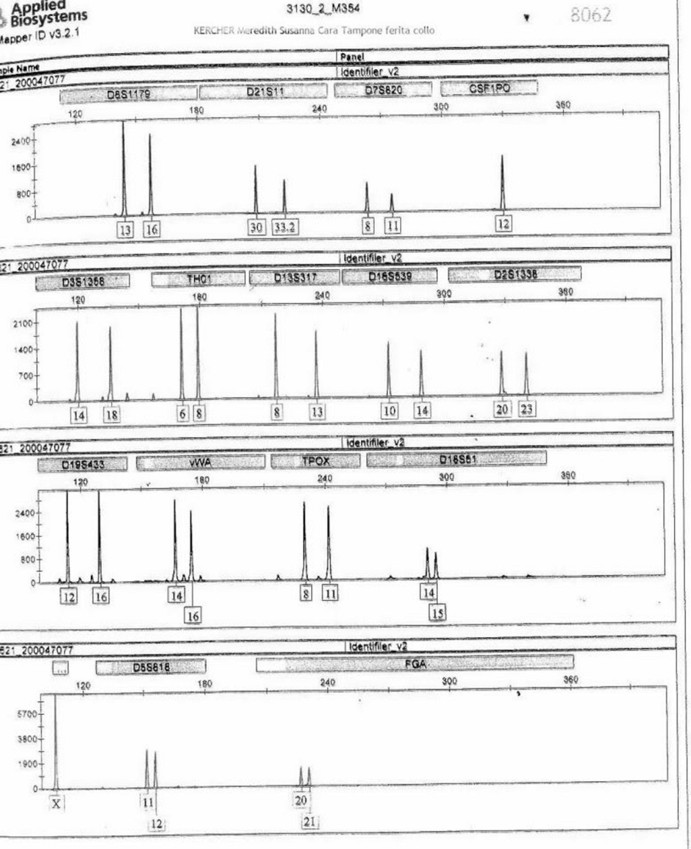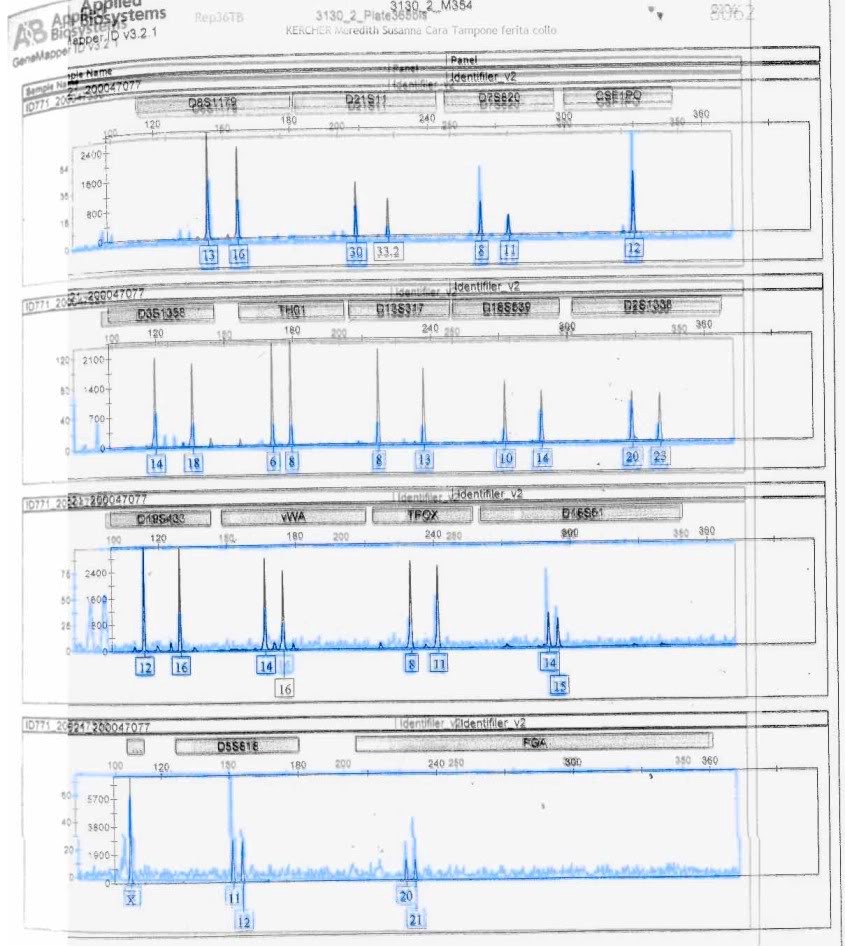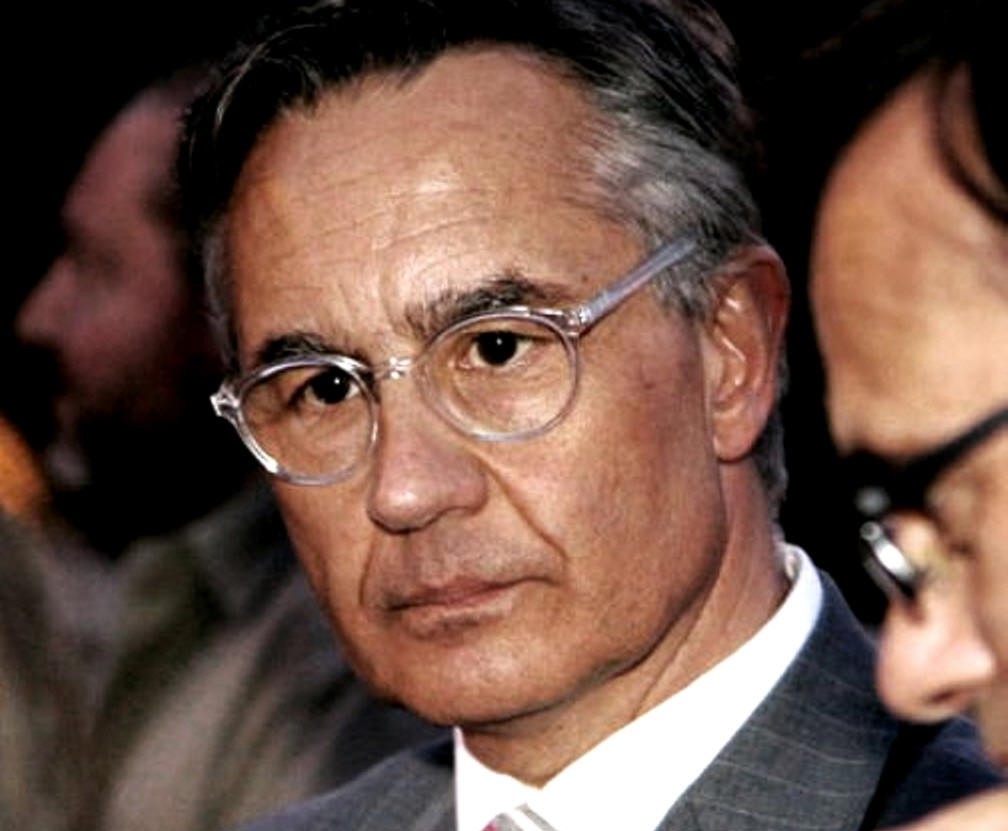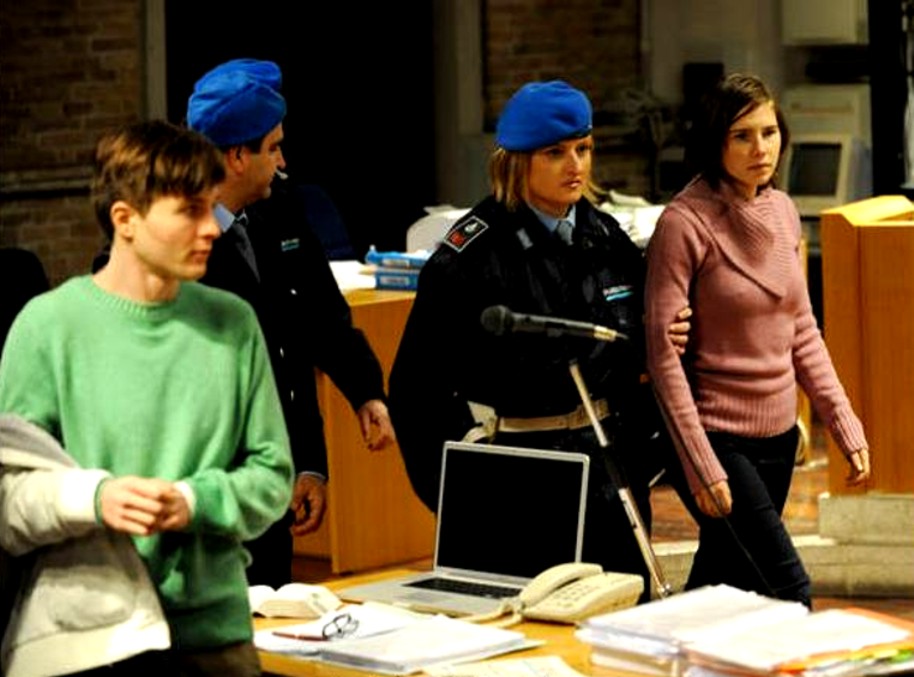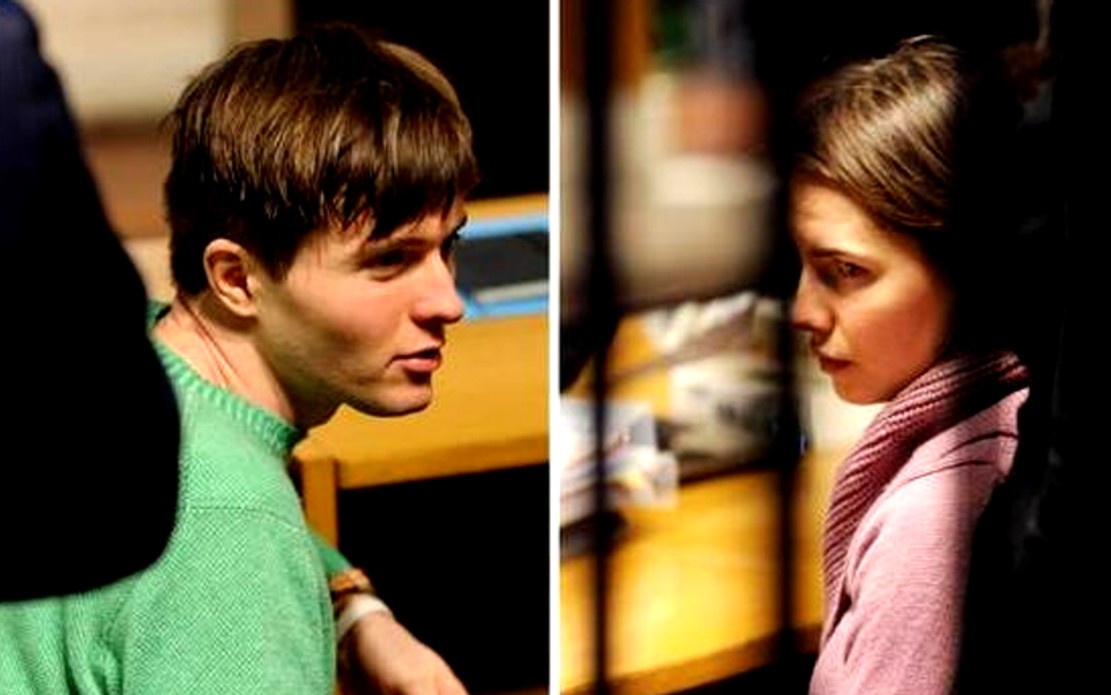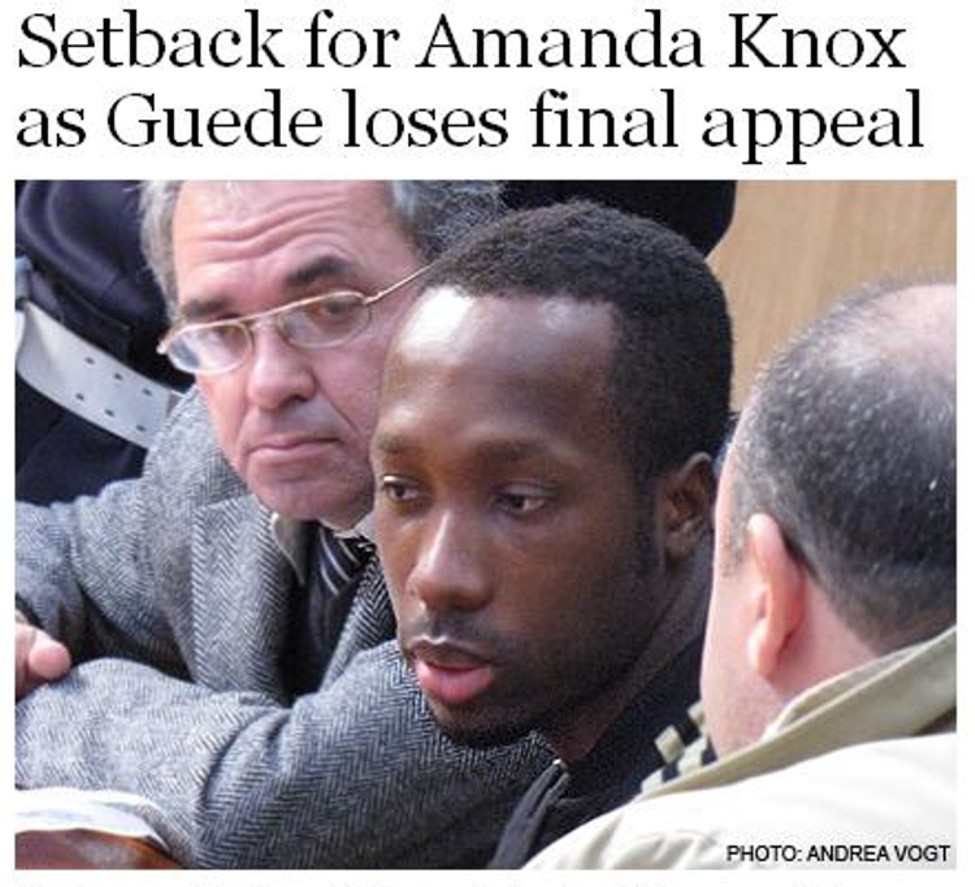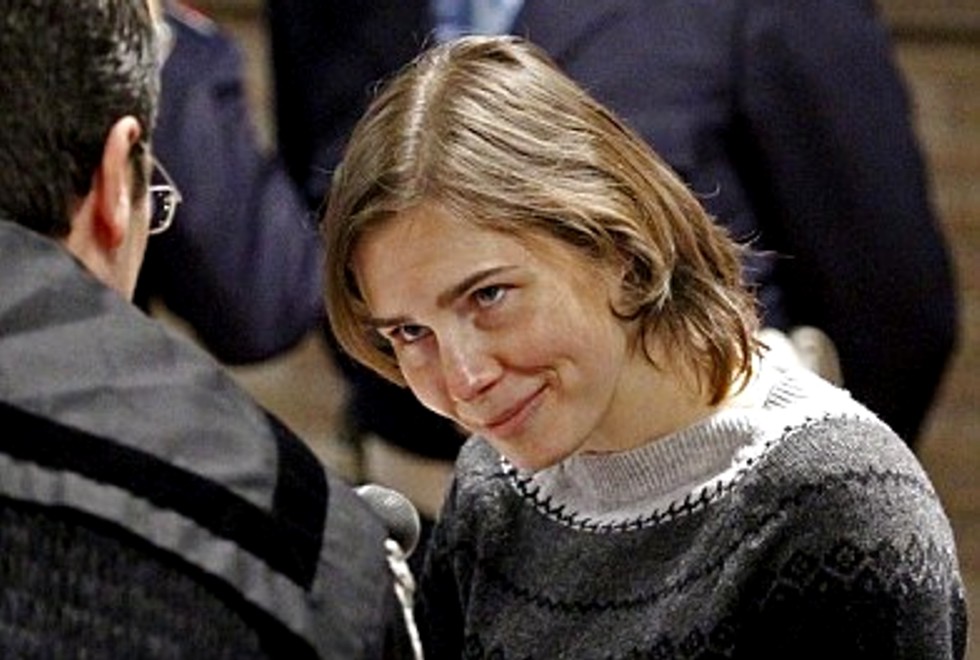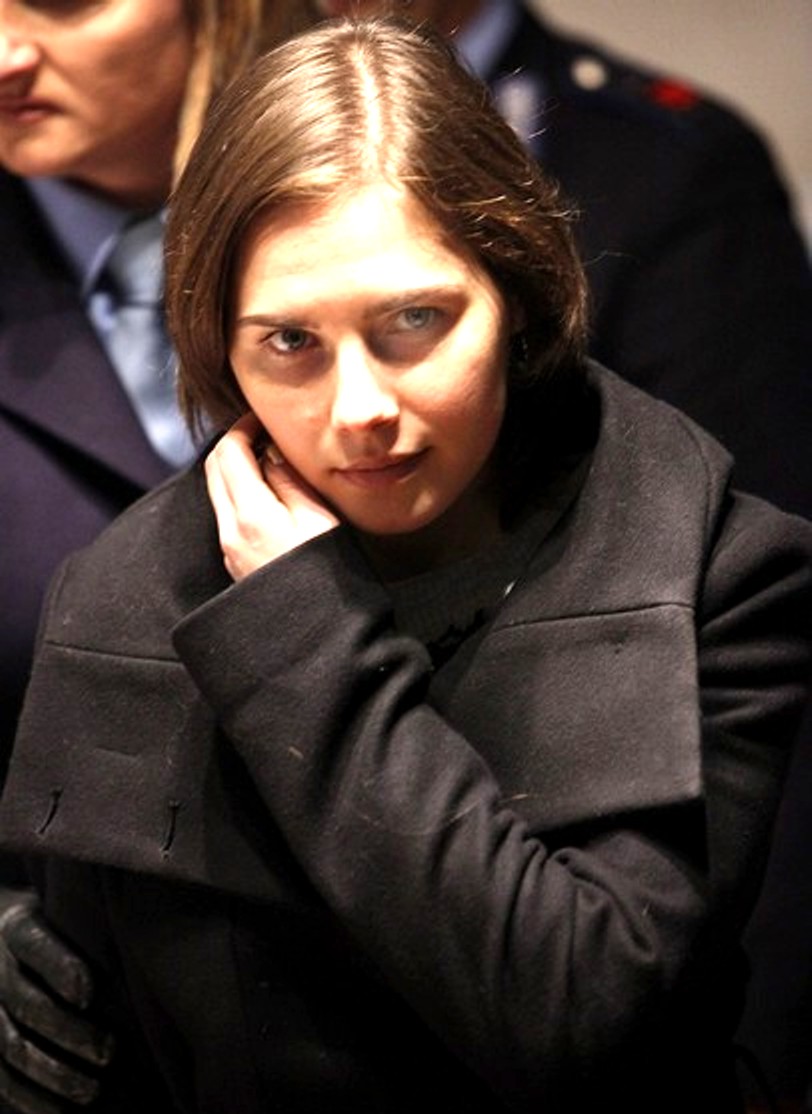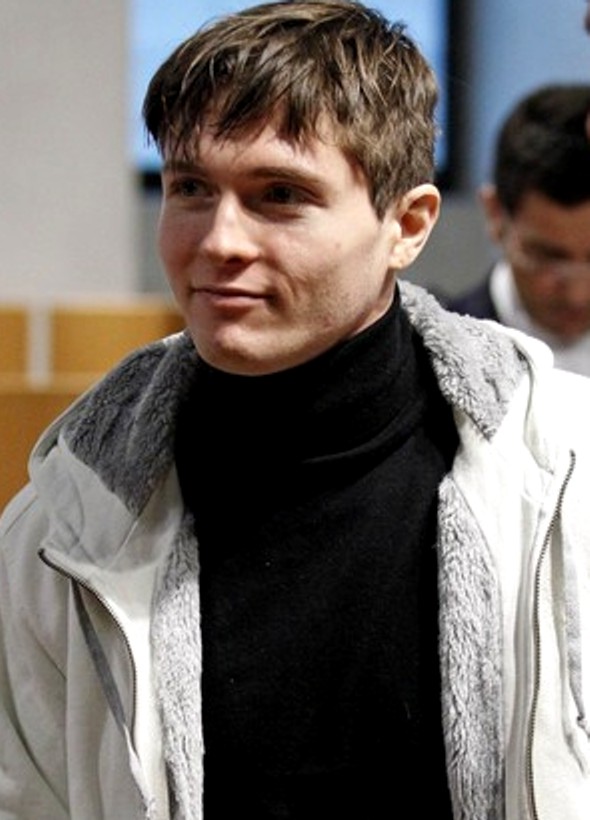
Category: Hellmann 2011+
Monday, December 20, 2010
The Limited DNA Reviews - Why They Probably Won’t Help Defense And May At A Stroke Be Game Over
Posted by The Machine
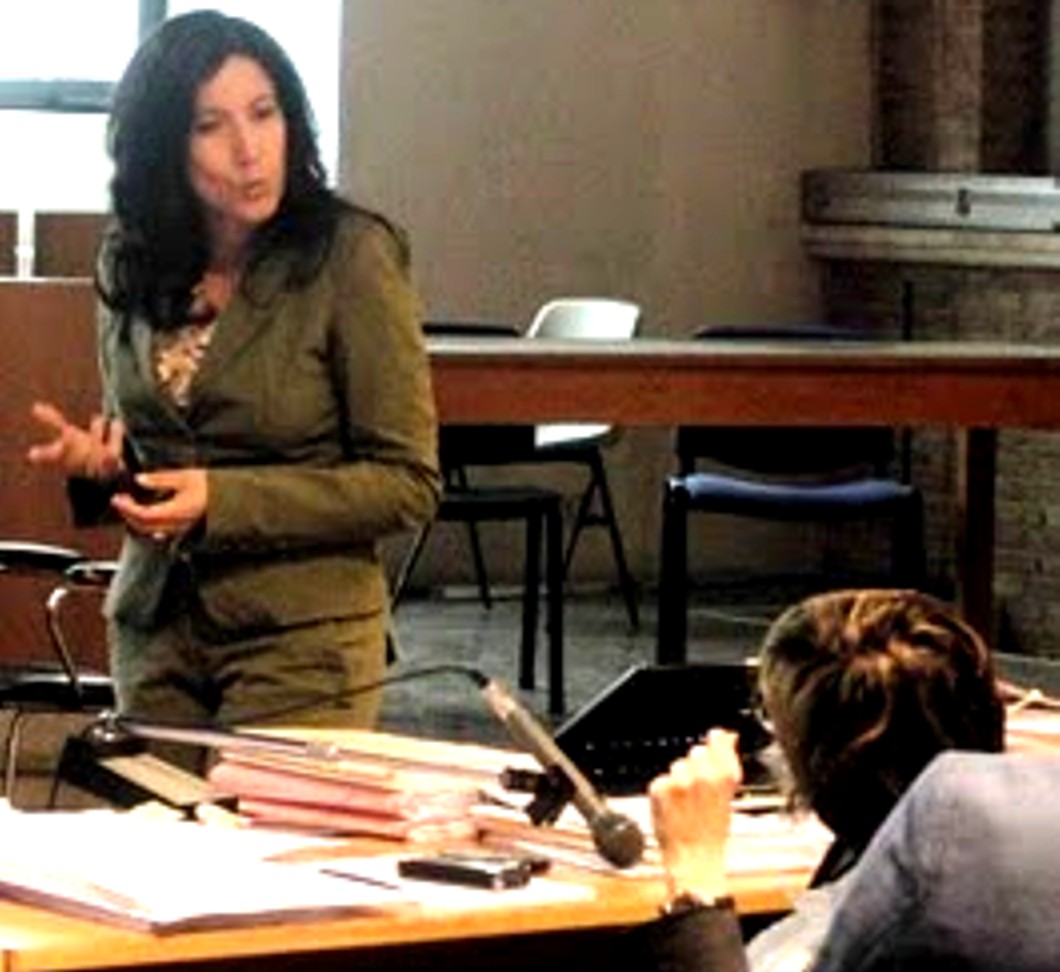
[Above: Dr Stefanoni at trial respoding to a question from Sollecito’s defense team]
Amanda Knox and Raffaele Sollecito and their families were jubilant at Judge Claudio Pratillo Hellman’s decision to allow an independent review of some key forensic evidence.
Two experts from Rome’s Sapienza University - Professor Stefano Conti and Professor Carla Vecchiotti - have already been nominated by the appeal court (they will be confirmed in January) to do an independent review of the forensic evidence.
Late saturday and sunday many of the journalists covering Meredith’s case saw Judge Hellmann’s decision as a major victory for the defence teams. Several giddy journalists even reported that somehow Amanda Knox had won her appeal.
However, two very important facts were lost in all the hullaballoo surrounding Judge Hellmann’s decision about this independent review..
First, the original forensic investigation and tests already were carried out by independent experts. Dr. Stefanoni and her team were from Rome, and they worked for another arm of the government. They weren’t hired by the prosecution to blindly confirm their suspicions that Amanda Knox, Raffaele Sollecito and Diya Lumumba were involved in Meredith’s murder.
And many people seem to be unaware of the fact that it was not Amanda Knox recanting her false accusation, but the DNA testing work of Dr. Stefanoni and her team that led to the release of Diya Lumumba. In this case Dr Stefanoni has high credibility.
Second, a number of experts have ALREADY carried out independent reviews of the DNA and forensic evidence and some of them have testified at court hearings in the course of 2008 and 2009.
In this post, we will take a look at some of the experts involved in the original DNA tests and the subsequent reviews and consider the implications of the new review, including some possible unexpected stings in the tail.
1) The Original Tests
Dr. Patrizia Stefanoni is one of the leading forensic experts in Italy and she was part of the the Disaster Investigations Teams sent to identify victims of the south Asian tsumani in 2004. She had to pass a series of stringent state tests to join the scientific police in Rome. She led the forensic investigation into Meredith’s murder and was responsible for carrying out the DNA tests and interpreting the results.
The Double DNA Knife
Dr. Stefanoni found seven traces of human flesh (human tissue cells) on the large kitchen knife sequestered from Sollecito’s kitchen. There was only enough DNA for one test. However, the results of non-repetitive tests are allowed to be entered as evidence in Italy.
The defence teams are notified of the date and time of all non-repetitive tests to make sure that they can be present to observe that correct procedures are adhered to. If they miss the tests or don’t stay for the full (often long) duration they have not carried out their full mandate to their client (they might even be liable for malpractice) and the defense has no right to claim wrong procedures or lab contamination.
Dr. Stefanoni testified at the trial that the one test she did “reliably” identified the DNA as Meredith’s.
Italian TJMK poster and DNA specialist Nicki explained in May 2009 why the DNA on the blade of the knife was a definite match to Meredith’s DNA:
Two genetic profiles are identical and therefore belong to the same individual if a) they are in the same position, and b) they have identical shape and dimension. In this case, each peak produced in the original samples exactly corresponds to the peaks yielded by the knife sample, position, shape and dimension.
[Below: DNA on the blade of the knife(top chart), Meredith’s DNA(second chart), and the two superimposed]
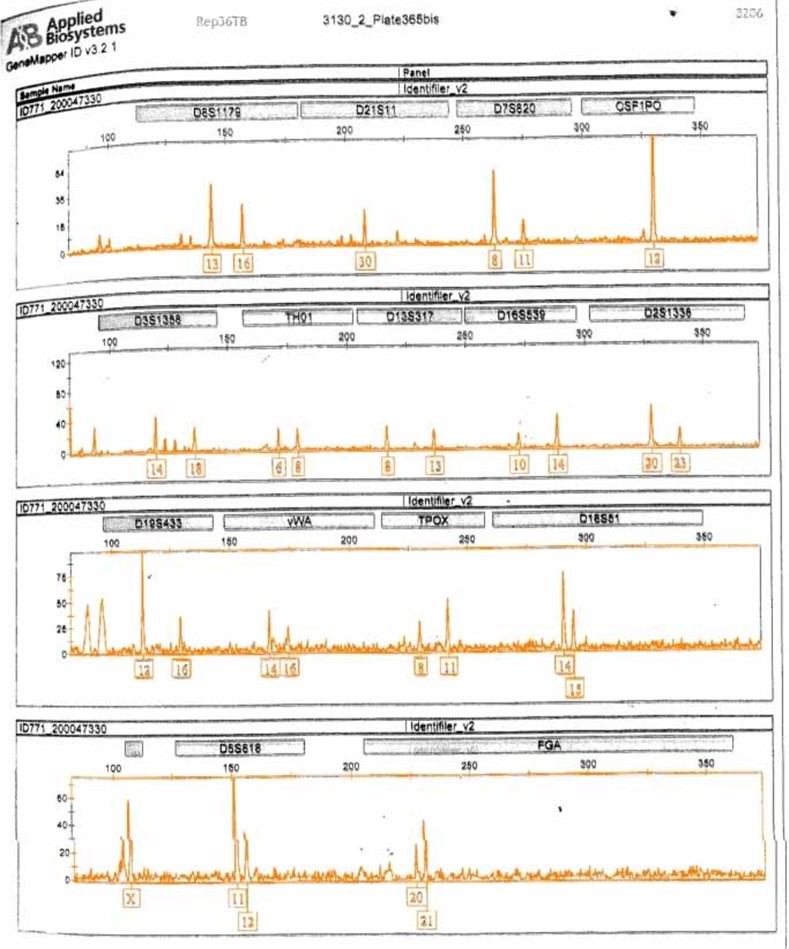
The Bra Clasp
Sollecito’s DNA on Meredith’s bra clasp was identified by two separate DNA tests. Judge Massei rejected defence claims that Sollecito’s DNA was LCN DNA and noted that there was no reason to doubt the reliability of the result:
It has already been said that Dr. Stefanoni had reported that on the [bra] hook (Exhibit 165B) the mixed genetic profile attributable to the victim and to Raffaele Sollecito was found; looking at the electropherogram, the ratio had been estimated in the proportion of 1 to 6 (the victim’s DNA being six times that of Sollecito); the quantity of DNA found could not be considered terribly small because there were several peaks that easily exceeded 1000 RFU, and no [317] repetition of the analysis had been carried out because the peak height of the smaller fraction of DNA was good, such that there was no reason to doubt the reliability of the result.
2) Independent Reviews
Dr. Renato Biondo
There was an independent review of the forensic evidence in 2008.
Dr. Renato Biondo, the head of the DNA unit of the scientific police, reviewed Dr. Stefanoni’s investigation and the forensic findings. He testified at Rudy Guede’s fast track trial in October 2008 and confirmed that all the forensic findings were accurate and reliable.
He also praised the work of Dr. Stefanoni and her team. “We are confirming the reliability of the information collected from the scene of the crime and at the same time, the professionalism and excellence of our work.”
Professor Francesca Torricelli
The Kercher family hired their own DNA expert, Professor Francesca Torricelli, and asked her to examine the DNA evidence.
Professor Torricelli is the Director of a genetic facility at Careggi University Hospital and has been working in genetics since 1976. She testified at Knox’s and Sollecito’s trial last and she also confirmed Dr. Stefanoni’s findings.
She told the court that the significant amount of Sollecito’s DNA on Meredith’s bra clasp meant that it was unlikely that it was left by contamination. She also agreed with Dr. Stefanoni that Meredith’s DNA was on the blade of the double DNA knife.
General Luciano Garofano (image above)
Distinguished DNA expert and former Caribinieri General Luciano Garofano analysed the DNA and forensic evidence for the early 2010 book “Darkness Descending”.
He has more than 32 years of forensics experience and is a member of the American Academy of Forensic Sciences. In his section of the book he explains at length why he too thinks that Knox and Sollecito are guilty of Meredith’s murder.
In an interview with The Sun’s Nick Francis, he said that the right people had been convicted: “I believe the police have prosecuted and convicted the right people, even if they got some of the details wrong.”
He told reporter Andrea Vogt that there wasn’t enough evidence to overturn Knox’s and Sollecito’s convictions: “I do not believe that there is enough evidence to convince an Italian magistrate and jury to overturn this conviction”.
Dr. Anna Barbaro
Rudy Guede’s defense lawyers hired their own forensic expert, Dr. Anna Barbaro, and asked her to examine the DNA evidence.
She didn’t dispute the DNA evidence against Guede, Knox or Sollecito. Guede’s lawyers claim that there was an innocent explanation for his DNA being at the crime scene and that Knox’s and Sollecito’s DNA implicated them.
Guede lawyer Walter Biscotti noted that the evidence against Knox was particularly strong.
3) The original prosecution team
Both Prosecutor Mignini and Prosecutor Comodi said after the appeal session on saturday that they are are confident that the independent review of the DNA and forensic evidence will confirm the sentences and verdict.
Mr Mignini
:
I don’t agree with the request and I see it as a waste of time. The judge did not criticise the methods that were used to collect and test the DNA….. The review was granted because the jury needed help to interpret the findings as they are difficult to understand. I don’t see how it is a victory for the defence, as the methods were not criticised in the ruling. The review will confirm the sentence and the verdict will stand.
Ms Comodi
As far as I am concerned this independent review will just confirm the excellent work carried out by the police scientific unit. The judge did not actually explain why he was allowing this review and although I do not agree with it I am sure it will underline the job originally done.
4) Two possible game-overs
Re-examination of the knife
In “Darkness Descending” the former Carabinieri General Garofano wrote that the police should have separated the plastic handle from the knife and checked for blood there.
The defence teams will regret having asked for the independent review if the new experts do this and they find there a testable quantity of Meredith’s blood.
Re-examination of the bra clasp
According to the authors of “Darkness Descending” Dr. Stefanoni found highly suggestive evidence of Amanda Knox’s DNA on Meredith’s bra. Raffaele Sollecito’s forensic expert, Professor Torre, also claimed that he had found Knox’s DNA on Meredith’s bra strap.
It seems that another forensic expert Vincenzo Pascali ALSO found Knox’s DNA on Meredith’s bra. The reporter Barbie Nadeau wrote the following:
Vincenzo Pascali, the chief forensic consultant who was set to give expert testimony about the possible contamination of the bra clasp, walked off the case last month, reportedly leaving a €50,000 bill. Back in September, Pascali, who declined to comment for this story, hinted that the clasp also contained Knox’s DNA.
And so in conclusion
One to two years later DNA testing techniques have improved, and also there is the sleeper of what is under the handle of the knife.
The defence teams’ insistence on an independent review could really explode in their faces if the new experts confirm more of Meredith’s DNA on the knife (Knox’s DNA is there very strongly) and that Knox’s DNA is on Meredith’s bra.
Saturday, December 18, 2010
First Reports On Scope Of Appeal Sounds Like Maybe A Setback For The Defenses
Posted by Peter Quennell
The first full reports are not out yet. This is a first quick take on the Italian reporting and may be subject to correction.
Some of the Cassation’s hard-line decision for rejecting Rudy Guede ‘s 10 appeal grounds in Rome on thursday will indeed be accepted into this appeal for the judges’ consideration.
The judges are agreeing to the defense request for a review of the testing of the DNA on the bra clasp and the large knife, though of course nobody - nobody - so far has ever proved contamination as the prosecutors today pointed out.
Two Rome experts in DNA have already been nominated.
Apparently none of the other very extensive forensic evidence at the scene of the crime - which is the entire apartment, not merely Meredith’s bedroom - is to be retested. That has always been very tough to explain away.
Apparently only one or two of the previous witnesses whose testimony is described in the Massei report will be heard from again. Possible Guede confidant Alessi will be allowed and maybe Aviello who claimed his missing brother really did it.
And apparently ninety days is added to the allowed duration of this appeal, because the Massei Report took 90 days to produce. The deadline now is next September, although if it lasts through to the spring we will be surprised.
The defense doesn’t seem to have many strong hopes going forward. No more Spiderman attempts on Filomena’s window. They found no room for appeal with regard to the various contradictory alibis, the various peculiar phone calls, and assorted bizarre behaviors.
Remember that even Knox and Sollecito themselves have claimed they were zonked out of their skulls on the night - though magically they seem to have managed a major cleanup and rearrangement of the entire crime scene, minus evidence pointing to Guede.
The astute commenter Piktor posted this on PMF
The expert review would be needed if the scientific results were the only evidence that convicts.
What if the DNA evidence was thrown out. Could you convict without it?
You have the staging, the lies, the false accusation, the police testimony, the defendant’s multiple alibis that don’t mesh, Mrs. Mellas testimony in court exposing Knox’s willful “confusion”, the email and diaries.
You add it up and it all points in one direction. No doubt about the result.
The prosecution narrative makes sense. The defence has no narrative.
The Appeal’s Set Limits: What The Judges Allowed Today And Didn’t Might Tell Us A Lot
Posted by TomM
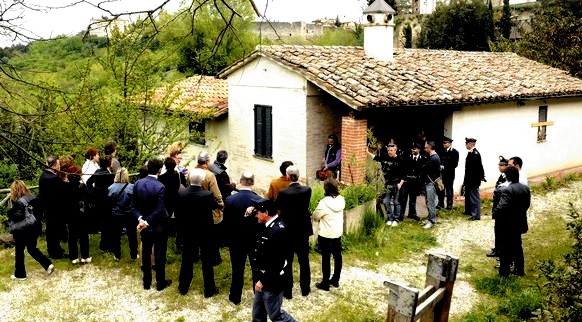
[Massei court deciding whether to buy spiderman theory; they didn’t]
1. The Context Of These Remarks
The judge ruled on the appeal’s inclusions and exclusions today. I’ll summarise what they are and how American courts might have differed.
I really do not understand why the defense and the family are so happy with this review, which is very limited and not complete in any sense - other than, perhaps, the “any port in a storm” phenomenon.
From my view in the bleachers, there are way more risks to the defense than to the prosecution from Saturday’s rulings.
2. What’s Allowed In Italian Appeals V. American
As a California lawyer familiar with trials and appeals in my state, watching the Meredith Kercher murder trial wind its way through the Italian legal system has been a learning experience.
It is a system with more protections than the one I know first-hand. The case is now in its first appeal phase, and proceeds far differently from the way it would in the US.
- If Knox and Sollecito had been convicted in an American court (which an American court would have had no difficulty in doing) less helpful presumptions would be applied to their appeal.
- In Italy they are convicted, and for that reason they are imprisoned and the visitation privileges they had before the jury’s verdict have been reduced. But for purposes of weighing the evidence in the appeal, they are presumed innocent.
- In the US, the court of appeal would not presume them innocent or guilty; it would regard them as having been adjudged guilty.
- In Italy, they can ask for the court of appeal to hear testimony from new witnesses and seek to introduce additional evidence.
- In the US, the appeal would be on the basis of the clerk’s and reporter’s transcripts of the trial. In the US the jury at the original trial would have been instructed that if an item of evidence can be interpreted two ways, one favoring guilt and one favoring innocence, they should accept the interpretation that favors innocence. But not so on appeal; the court of appeal would interpret all the inferences from the evidence in the light most favorable to the prosecution.
- An American court of appeal would not consider an attack on the credibility of a witness unless the testimony was such that no reasonable person would believe the testimony.Thus, an attack on the testimony of Curatolo would have no chance of success on appeal. In fact, jury instruction in the US would give the jury blessing to believe him even absent disco buses running that fatal night.
From a form jury instruction on how to judge witness credibility:
“Do not automatically reject testimony just because of inconsistencies or conflicts. Consider whether the differences are important or not. People sometimes honestly forget things or make mistakes about what they remember. Also, two people may witness the same event yet see or hear it differently.”
The Italian appeal is described as a “trial de novo”.
- In common law jurisprudence, a trial de novo is simply a new trial, and the jury in a new trial would not even be told of the existence of the first trial. It would be done as if the first trial never happened.
- Not so in Italy. The jury and lay judges have full access to the case dossier, the Massei Motivazione, and the briefs of the parties. They decide which parts of the case should receive new evidence, and the parts where none is needed. If that were not the case, they would not know how to respond to the defense requests.
3. Tellingly, What Court Has NOT Re-opened
1. Staging Of Burglary
It is significant that there is no re-visit on the staging of the burglary. This charge is not just one of the things used to prove the murder, it is also a separate charge which does not require that a person also have participated in the murder.
Let’s suspend disbelief a moment. Suppose AK and RS had not been present during the murder, having ducked out briefly to get more drugs, but returned to discover Meredith’s body.
Suppose they thought they would be suspects because they had let Rudy in and feared they would be blamed, so they staged the burglary to divert suspicion from themselves. In this hypothetical situation, they are still guilty of staging a burglary even if they didn’t otherwise participate in the crime.
So, what to make out of the fact that no further evaluation will be made of the staging?
This seems like the easiest of the charges to prove and the most difficult to defend. Staging is a recognized phenomenon in criminal investigations and the defense expert did not fare well under cross-examination. I don’t see how the court would reverse the judgment on this issue given the state of the record.
2. Collection Of DNA
Defense criticized the way the dna was collected from the bidet, but there will be no review of that evidence - or of any other of the mixed blood/dna evidence - only the knife and the bra clasp.
If the appellate jurors’ inclination were to think there is reasonable doubt on the dna, there is plenty of defense expert testimony to hang that hat on. That only two of the exhibits will be studied shows that they do not question the work of the scientific police as a whole.
4. The Pattern Of Sorts In These Rulings
From my own experience, I firmly believe that Hellman has not made up his mind on the final outcome. That doesn’t mean he doesn’t know what he thinks the jury will do with the case.
He clearly knows the case, and I think he knows if there are areas in Massei’s reasoning that have vulnerabilities (not necessarily fatal) that could attract attention in the Court of Cassation.
I think he knows whether the prosecution’s case is a house of cards, or if it is a good case with some curable cosmetic flaws.
To me, the rulings look like the judge has reviewed the case, thinks it is fundamentally sound, and believes it will be backed up by unbiased expert opinion - and if it doesn’t, he will assess what impact that has on the case.
The issue with respect to the scientific police is not that they were biased in the sense of falsifying evidence to wrongfully convict, but that the video of the crime scene investigation showed non-textbook acts, Stefanoni didn’t leave a complete paper trail in testing the knife, and they failed to collect and correctly bag the bra clasp at the beginning.
All of which left an opening for the defense to claim the dna evidence is suspect. There is a reason why teachers don’t let students grade their own papers, I think that concept is behind Hellman’s decision to seek an unbiased review of these two items.
5. No Signs Of Exoneration In Rulings
If Rudy Guede testifies and gives a believable narrative, it may not matter what the two dna reviews say, and it might also undermine the jurors’ inclination to accept the theory of remorse from the covering with the quilt that persuaded Massei to reduce the sentence.
An increased sentence is not out of the question.
As I said at the top, I really do not understand why the defense and the family are so happy with this review, which is very limited and not complete in any sense - other than, perhaps, the “any port in a storm” phenomenon.
The bra clasp evidence is not going to go away, and there is the risk that increased technical sophistication could result in identifying a complete dna profile of Amada Knox on it. If they disassemble the knife, there could be abundant blood between the handle and the blade.
Again, from my view in the bleachers, there are way more risks to the defense than to the prosecution from Saturday’s rulings.
Friday, December 17, 2010
Stinging Guede Final Appeal Rejection Suggests Trouble For Knox and Sollecito
Posted by Peter Quennell
Rudy Guede’s appeal is rejected on all ten grounds.
His appeal grounds were ugly and dishonest and he has no further appeal. He will serve his 16 years, with maybe some time off, for being a savage willing party to the cruel stupid murder of Meredith.
Rudy Guede will go down in infamy for his sex crime against a defenseless victim, for being a party to a taunting torturing knife attack, for claiming Meredith invited him in for consensual sex, and for not calling for help for Meredith and maybe saving her life while it was still possible.
Cassation continues the fine Italian court tradition in this case of taking a firm and unblinking position, and for being utterly oblivious to the vile over-the-top campaign of Curt Knox, Edda Mellas and David Marriott which may now haunt Amanda Knox all of her life..
This is clearly not a final court of appeal that is now going to turn on a dime and say when they hear the final appeals of Amanda Knox and Raffaele Sollecito, oh, of course, we got that previous decision wrong, and of course Guede did it alone.
Here is the cool clear report of Andrea Vogt, this time being published in the UK’s First Post. The highlights:
1) On rejecting Guede’s ludicrous tale.
Put simply, no judge or magistrate has believed Guede’s story that he was in the bathroom of the apartment the two girls shared in Perugia, listening to music on his iPod while someone else stabbed Meredith.
According to Guede’s story, when he came out of the bathroom he found Meredith bleeding to death and tried to staunch the flow of blood ““ hence the discovery of his DNA by investigators.
2) On the huge new risk now for Sollecito and Knox.
Under Italian law, all documentation from Guede’s various hearings can now be introduced into the appeal trial of Knox and her former boyfriend, Raffaele Sollecito, which reconvenes in Perugia tomorrow.
The problem for Knox and Sollecito is that Guede’s trial documents will include the judges’ reasons for convicting Guede and denying his appeals: namely, that they believe all three ““ Guede, Knox and Sollecito - killed Meredith together.
3) On Kercher family lawyer Maresca possibly demanding Guede testify
“Guede can now be called to testify and we are considering, along with the prosecutors, if we will request that Saturday or not,” said the Kercher family’s attorney Francesco Maresca in Rome.
“We will ask that the high court decision be admitted, as it stabilises the facts and is an important point of reference, with judges confirming the reconstruction of events and the involvement of the other two suspects in this dramatic ordeal in which a young woman lost her life.”
If Guede is called, it is unclear whether he would be considered a reliable witness given that no court has believed his story so far. And the situation is further complicated by conflicting stories about Guede’s take on Knox and Sollecito.
4) On the prospects for requested defense witnesses Alessi and Aviello
Guede is also the subject of a mysterious 10-page letter from prison, written on blue notepaper in the feathery script of convicted child murderer Mario Alessi, and now sitting in a lawyer’s office in Parma.
Alessi claims to have heard the real story of what happened while stuck in a prison cell across from Guede. Three other inmates signed each page of Alessi’s letter bolstering his story - that Guede said repeatedly in his cell and the prison yard that Knox and Sollecito had nothing to do with the crime. (Guede denies the conversations)...
Will the judge overseeing Knox and Sollecito’s appeal in Perugia request it? If he does, it could be entered into evidence alongside further controversial letters, these from a Neapolitan mafia snitch named Luciano Aviello. Aviello claims that his own brother killed Kercher…
Since Knox and Sollecito were convicted and jailed a year ago.. these stories of intrigue have found their way out from behind the prison walls across Italy, from the sex offender ward in Viterbo to the high security penitentiaries in Prato and Turin.
5) And on John Kercher’s recent strong protest against the profiting from Meredith’s death
Meredith Kercher’s bereaved family this month broke a three-year silence to speak out against Knox’s “minor celebrity” status and the high-profile publicity campaign her family and supporters have been waging to claim wrongful conviction.
Thursday, December 16, 2010
As Amanda Knox Via Her Statement Has Now Placed “Will She Testify?” Front And Center…
Posted by Cardiol MD
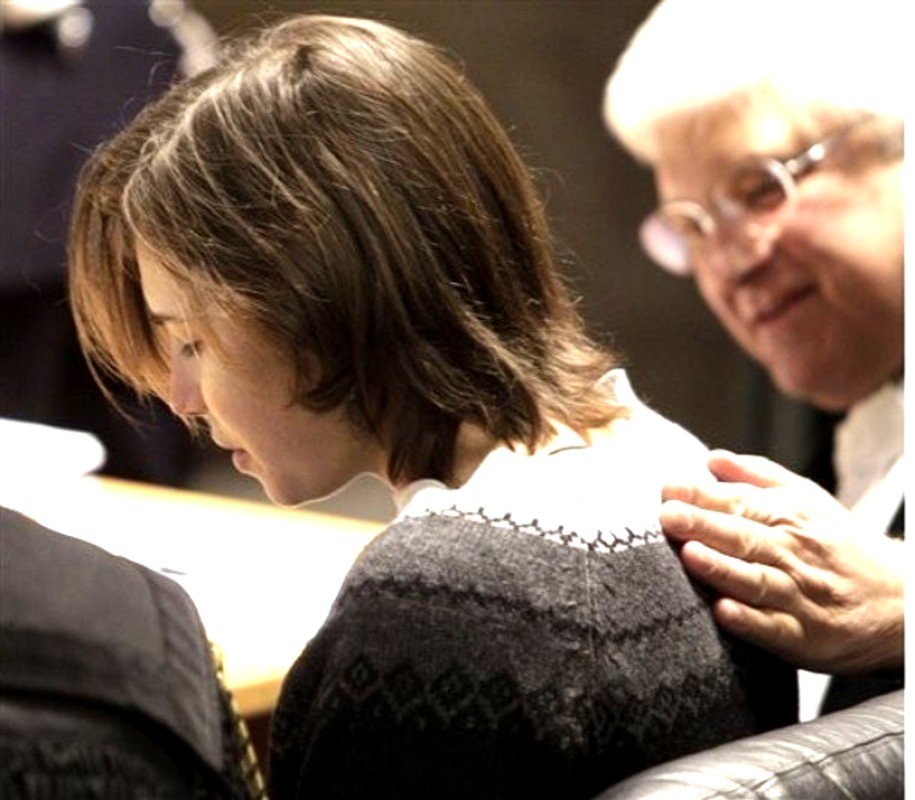
She sure has created an interesting cliffhanger.
Last Saturday Amanda Knox spoke from her seat beside her defense team and she was not subjected to cross-examination.
If she does choose to mount the stand to back up her claims with some testimony, she will be subject to cross examination, as will Raffaele Sollecito.
What may the judges and lay judges be allowed to deduce if neither of them mount the stand, or alternatively refuse to answer?
This involves the legal concepts of the Privilege against Self-Incrimination, the Right to Silence, and the Right to Lie.
In the US prosecutors are prohibited from commenting adversely on a defendant’s Exercise of the Right to Silence at trial, on the argument that doing so would violate the privilege against self-incrimination.
But this may be circumvented as demonstrated in the Duke lacrosse-team rape frame-up by the prosecutor.
The DukeLax prosecutor (echoed by many others in Durham and elsewhere) falsely alleged, publicly, a lacrosse-player “wall-of-silence” as persuasive evidence in favor of guilt, even when he knew full-well that the Laxers had transparently cooperated with prosecutorial investigators.
So much for “enshrinement” of the right to silence in the US.
There is no argument that in all three countries, Italy and the US and the UK, criminal defendants have the right to remain silent. This means that they do not have to speak in their own defence, if they choose not to do so.
However, Italy takes the privilege against self-incrimination such a giant step further that a guilty defendant, if given the choice, might be wise to choose trial in Italy, in preference to trial in either the US. or the UK.:
First, there is a significant difference between the use of the word “testify” in Anglo-American common law and its use in Italian law. Iin the former a testifying-defendant is sworn to tell the truth under oath and pain of perjury. Iin the latter, a defendant, when called to the stand, is not even “a witness”, and is not under oath:
According to the Italian Code of Criminal Procedure a defendant can be called to speak, but may refuse to “bear testimony”
Technically, a defendant does not “bear testimony”, or testify; a defendant is not even “a witness” ; in Italian, a witness is interrogato, whereas a defendant is esaminato and may refuse to answer many questions.
A defendant, in Italy, can also lie without fear of legal sanction.
Since a defendant does not take an oath and since a defendant is not technically a witness, if a defendant tells a lie, the defendant is not committing perjury.
A defendant can choose to make spontaneous statements to the Judge; and can tell whatever she/he wishes to tell and can choose not to answer any questions. In the Perugia case too, a defendant can lie without legal sanction.
So, if Amanda Knox speaks at her trial, neither the Judges, the Prosecutors, nor Defendant’s Counsel neccessarily expect her to speak the truth - they may expect her to lie her head off.
Prosecutors will not try to directly expose her lies so much as they will try to expose the contradictions in her various statements.
Amanda Knox’s prepared statement-to-the-court at her trial [as opposed to her testimony] restricted itself to the subject of the false accusations she made against Patrick Lumumba. This unsworn statement could not be submitted to cross-examination. Such unsworn statements are also possible in the other jurisdictions.
In the case of the Meredith;s murder there seems to be an ample supply of evidence showing their guilt, such as the multiple contradictions both between and within their statements.
Furthermore, even if no one, ever, comments adversely on these defendant’s exercise of the right to silence, think of Simon and Garfunkel’s famous “Sounds of Silence”
That song reminds us that finders-of-fact, at least subliminally, can hardly avoid being influenced by accused defendants’ silence.
Saturday, December 11, 2010
Kercher Family Lawyer Walks Out As Amanda Knox Engages In What Looks Like Yet Another Stunt
Posted by Peter Quennell
The other day Meredith’s father John made a strong plea for the cruel and callous PR games to stop.
John Kercher made it pretty clear that he disbelieves EVERYTHING now that Amanda Knox and her parents say in their endless media quotes and appearance. The English version of John Kercher’s letter is here and the Italian version is here.
Amanda Knox’s mother Edda Mellas was almost immediately reported as reacting to John Kercher thus:
Mellas also addressed the issue today on KIRO Radio in Seattle saying the Kerchers do not “know the whole story.” She said they were not in court except for a few days during Amanda’s trial and feels that they fell “hook, line and sinker” for what their lawyer and prosecutors told them. “They may not have the whole picture,” she said.
That callous and inaccurate reaction did Edda Mellas no good at all. Many who were still cutting her a little slack were appalled by this dishonest and smearing attack.
In fact the Kercher family have been extremely well informed and they have remained singularly cool-headed, dignified and truthful throughout. .
Unlike Edda Mellas they have actually read the Massei Sentencing Report. Unlike Edda Mellas they show no signs of having swallowed anything hook line and sinker. Unlike Edda Mellas they do not again and again lie about basic facts of the case. Unlike Edda Mellas, they did not hide the fact that an innocent man, Patrick Lumumba, was in jail because Amanda Knox lied to put him there.
And unlike Edda Mellas their view of Amanda Knox’s guilt is no different from maybe 95 per cent of the Italian population. They do get the whole picture.
Time for damage control? Today in court, Amanda Knox seemed to set out to try something completely different. A limited qualified evasive emotional non-explanation of an explanation. An “I didnt do it but I am so sorry for Meredith and her family anyway” kind of hangout.
To underline his contempt for this ploy, Mr Maresca conspicuously walked out of the court when Amanda Knox started her rambling nervous statement. If the statement actually won any new sympathy for her among the case-watchers in Italy, we are not seeing this reflected in the Italian media reports.
Here is Nick Pisa reporting objectively from Perugia in the Daily Telegraph - in his final para below, it seems he has the same interpretation of the real purpose of Amanda Knox’s statement as we do.
Knox, 23, broke down several times as she delivered an emotional 20-minute address to the court hearing her formal appeal against conviction, her voice sometimes quavering as she claimed that she had nothing to do with Miss Kercher’s brutal death.
The American dismissed the prosecution’s view of her, saying she was not the “dangerous, diabolical, jealous, uncaring and violent” person depicted during her original trial, telling the court: “That girl is not me.”
Knox also expressed her sympathy towards’s Miss Kercher’s family and friends and said through tears: “I am very sorry that Meredith is no longer here. I have little sisters as well and the thought of being without them terrorises me.
“What you are going through and what Meredith went through is unacceptable and incomprehensible. I remember Meredith and my heart breaks for you. I am honoured to have known her. I don’t know how you must feel, your suffering over a lost life.”
Knox’s words appeared to be in response to John Kercher, Meredith’s father, who recently complained that Knox had been accorded the “status of a minor celebrity” while his daughter was a forgotten victim.
Amazingly, all three of the largest US networks had Ella Mellas on their breakfast shows, unchallenged and fawning, to claim that Amanda Knox’s performance was amazing. Edda Mellas of course speaks no Italian.
Meanwhile, back in the real world, the Italian reporting highlighted Mr Maresca walking out and reported his highly critical statement verbatim. NO media website today carried a majority of pro-Knox comments.
And in making herself so obviously the center of the universe in her statement, Amanda Knox may have already cooked her own goose with the new judges.
[Below: This now is a full audio recording of the full statement of Amanda Knox with court images ]
The Two Convicted Seen Arriving For Their Weekly Date In Appeal Court
Posted by Peter Quennell
Tuesday, December 07, 2010
Andrea Vogt Provides Heads-Up On What May Happen In The Appeal
Posted by Peter Quennell
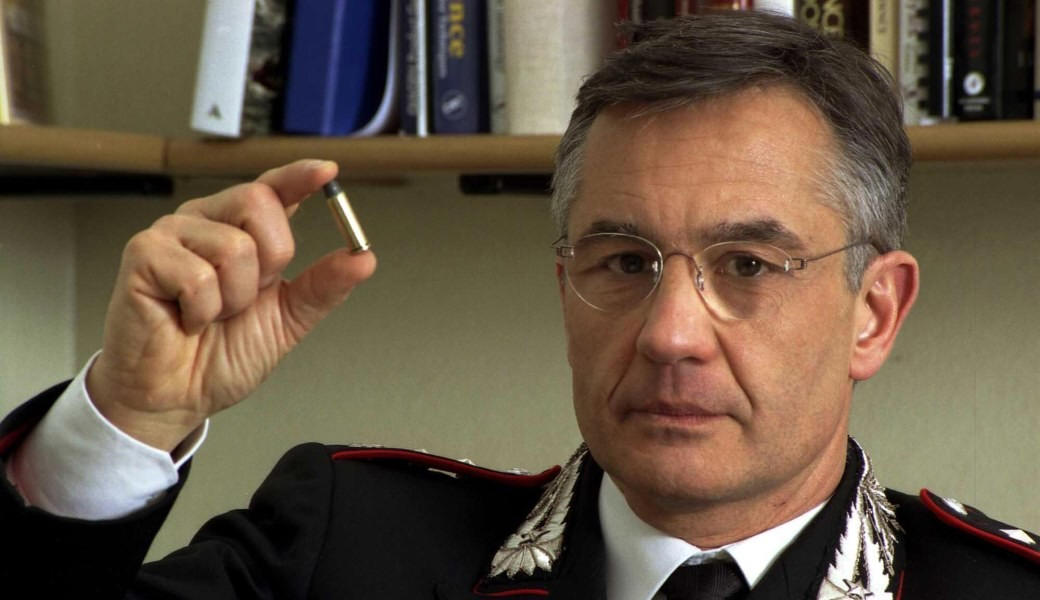
Luciano Garofano created Carabinieri DNA labs; quote below
Update On Pending RS And AK Appeal
Another of the many very informative reports that have appeared on the Seattle PI website.
A mild qualification up front is that we would have liked it mentioned that the prosecution have also initiated an appeal, to throw out the “mitigating circumstances” outlined in the Massei Report.
A reversal on the mitigating circumstances, which we too have always found problematical, could result in all three serving longer time. What the prosecution will come out with in that phase is a real sleeper in this appeal.
1. On John Kerchers article protesting the over-the-top PR campaign
The Kerchers have maintained their silence since their daughter’s murder, even as Knox’s parents appeared on national television in the United Kingdom, the U.S. and Italy. But that could change, as negotiations are under way with at least one national network to hear the Kerchers’ side of the story.
Correct and accurate. More on Meredith would be so welcome to an American audience. We reposted John Kercher’s hard-hitting article here in English and (as the Italian media mostly don’t yet know about it) here translated into Italian.
Biased reports like those of the ill-researched Nikki Batiste of ABC, which mis-stated and ridiculed John Kercher’s claims, omitted to say what Andrea Vogt says: this is THE FIRST TIME that John Kercher has gone public, in an attempt to stop the depraved multi-million-dollar deluge.
2. On the chances of an overturn of the December 2009 verdicts.
American pundits are quick to predict Knox could walk, but Italian legal experts say the chances of completely overturning her conviction aren’t good. More likely, they say, are the prospects of a sentence reduction.
“The Knox trial is one of the few, in the history of Italian criminal justice, in which over 25 judges have agreed—at different stages—on the adverse impact of the collected evidence against the positions of both Knox and Sollecito. In this respect, the case is rather unusual, as Italian justice is often characterised by conflicting decisions of courts on the same case,” said Stefano Maffei, an Oxford-educated professor of criminal law in Italy interviewed by seattlepi.com.
“What I can confirm is that courts of appeal are generally more lenient than courts of first instance, and I would not be surprised if the decision on appeal could bear a lower sentence for both defendants.”
The point is made up at the top here that this report does not mention the appeal of the prosecution for tougher sentences , which would seem to effectively balance out the probabilities that Mr Maffei and all the defenses now claim.
The sheer number of judges that all of them agreed on the evidence in this case is particularly damning. Our own Italian lawyers between them know of ZERO cases where so many judges in succession have found no reason to reverse any part of the process.
We have posted a number of good descriptions of how the Italian process actually works (these go beyond the descriptions in ANY British or American reporting, another sign of how sloppy it has mostly been), and our key posts can be seen here and here and here.
3. On the requested defense witness Mario Alessi
In a file tucked neatly under a polished glass paperweight in Laura Ferraboschi’s Parma law offices is a carefully guarded letter that Knox and Sollecito hope will set them free.
It is 10 pages, handwritten in the small, tilted script of Mario Alessi, a convicted murderer who had the prison cell across from Rudy Guede in the sex crimes ward of a tough prison just north of Rome….
Alessi mailed his statement to her for safekeeping after becoming concerned it might “disappear,” she said…. Sollecito’s lawyers, eager to have the letter at their disposition, asked Ferraboschi to share it, but she has refused, saying she did not feel it would be ethical to do so.
“Alessi sent the statement to me for protection, and I do not feel it is appropriate to give it to other lawyers who might drag him into a case that could negatively impact him,” Ferraboschi said. “If a judge requests the statement or his presence, then we will provide it.”
Good luck on that one. We doubt Alessi ever makes the stand. Here is our most recent post on Mario Alessi which links back to several that went before.
Prosecutors Mignini and Comodi also interviewed Alessi. They have not yet made public what he said.
Investigators and prison staff would have checked Alessi out very carefully. Laura Ferraboschi seems to be hanging firm on not sharing the letter, out of concern that Alessi could incure a charge of perjury.
4. On the requested defense witness Luciano Aviello
The second series of jailhouse “revelations” are from Luciano Aviello, a Mafia turncoat from Naples who shared a cell in Terni with Raffaele Sollecito. Knox’s lawyers went to videotape a statement from him in prison near Turin in March, a month after Bongiorno had videotaped Alessi’s statement in Viterbo.
He wrote several letters to the court last year. In the most recent statement, he claims he can prove all three people in jail for Kercher’s murder are innocent. It was his own brother, he says, who killed her. Aviello…
Aviello said his brother killed Kercher in a robbery gone awry, then asked Aviello to hide a bloody knife and set of house keys. Kercher’s set of house keys have not been found.
Good luck on that one too. We doubt that Aviello too ever makes the stand.
In our most recent post on him here we remarked that, with this guy, the defense was already seriously grasping at straws. We are amazed that they still want to wheel him out. That weak move does not bode well for Knox and Sollecito.
5. On the requests for more testing of the DNA
Repeatedly, judges have rejected defense arguments about the forensic evidence despite the slipshod way it was processed and Italy’s reputation of lagging behind the rest of Europe in DNA certification, handling protocols and databasing.
Many outside observers believe the court should allow for such an independent review, given the number of protocol mistakes revealed in the first trial.
Defense attorneys and their expert witnesses heavily criticized the work of police biologist Patrizia Stefanoni and the Perugia and Rome forensic teams working under her direction for such missteps as not changing gloves after picking up evidence, poor collection methods and incomplete records of how evidence was handled and in what exact order during later laboratory testing….
Two of the primary pieces of evidence against Knox and Sollecito are highly contested: A bra clasp originally catalogued in the first days after the murder that was picked up in a sweep of the crime scene 46 days later, and the kitchen knife with Knox’s DNA found on the handle and the victim’s DNA found on the blade. The bra clasp is said to contain Sollecito’s DNA. The amount of Kercher’s DNA found on the blade was such a trace amount it registered with a “too low” reading when analyzed.
Our DNA section on TJMK is very complete and to a very high standard. The three posts here and here and here are particularly worth a very careful read.
More tests had already been denied by Judge Massei. Defenses tend to like to do this, to keep insisting on more and more testing, until finally with luck an expert breaks their way.
The defense now “highly contests” the testing but they also attempted that throughout the trial and several of their experts under cross-examination had to take a step back.
Experts were invited to the one-time-only DNA testing of the knife and then (surprise, surprise) on the day of testing not all of them showed up.
And on whether Italy lags behind the rest of Europe on standards, see below (Italy doesn’t)..
6. On the standards of the laboratories that did the testing
A top geneticist at one of Europe’s top forensic labs at the University of Salzburg confirmed in an interview with seattlepi.com that it is possible to amplify such a small amount of DNA, as Stefanoni did, until DNA can be identified. But the expert added that it would not be allowable unless the result could be reproduced, something police biologist Stefanoni said under cross-examination could not be done.
The Salzburg geneticist, who does forensic testing for police agencies in neighboring Austria, said that in the university’s certified lab (which has the highest certification available in Germany and Austria) different operators are required to handle suspect and victim DNA and that the various phases of DNA analysis happen in different labs along a “one-way street” to avoid the possibility of contamination.
Such protocols were not in place in Rome. In fact, Italy is noted for being behind on international forensic standards. For example, it is one of the last (and only) European countries to have not yet become part of the Prum convention, which sets basic guidelines for sharing of DNA data and other security information.
The top geneticist at Salzburg University is unfortunately not named, presumably at his request, and there have been so many claims by both anonymous and unqualified self-proclaimed experts throughout this case that we wish he had said that yes, he could be named.
The Rome labs were in fact being operated to international standard and they had followed the European protocols for years. When they were only recently certified to European standards, none of the procedures or the training or the layout of the labs had to be changed.
Perhaps the top geneticist should have mentioned this.
7. And on the views of renowned forensic scientists Luciano Garofano
One of Italy’s top forensic biologists, retired Caribinieri General Luciano Garofano, is at the forefront of the push to introduce a national database and DNA certification standard in Italy. Garofano (a member of the American Academy of Forensic Sciences who collaborated frequently with the FBI over the years as a high-ranking Caribinieri military officer) analyzed the forensic evidence in the Perugia case for a book released shortly after the trial was complete.
He believes Knox was involved in the murder, but he disagreed with the court’s conclusion that Kercher was sexually assaulted—he is convinced Kercher’s death was a fight that degenerated, then later staged as a rape.
Interviewed by seattlepi.com, Garofano said his read of Knox’s appeal was that it was mostly a rehashing of “points that have already been debated…. The knife is a weak element . . . they could argue it should be thrown out because the amount of DNA does not meet international forensic standards. But that still leaves a lot of other evidence,” Garofano said.
“I do not believe there is enough there to convince an Italian magistrate and jury to overturn this conviction.”
Terrific comments. Hard to see why either Knox or Sollecito deserve even the slightest reduction of their sentence. Neither of them has come up with a consistent explanation, both of them seem to have shown some glee, and neither has shown the slightest sign of repentance.
If they tortured and killed Meredith in a particularly cruel and barbaric way, as it seems, then they both seriously need to serve the time.
Monday, December 06, 2010
Will Sollecito And Knox Finally Want To Take The Stand? Why Our Betting Is Against
Posted by Kermit
The Massei Report makes nothing of the fact that Amanda Knox and Raffaele Sollecito did not rise under oath in their defense.
But if that made zero impact on the perceptions of the judges and lay judges, we would be very surprised. There are VERY few cases in the US or Europe where an INNOCENT defendant (1) rose to testify, (2) was then found guilty and sentenced, and (3) and was later found to be innocent after all.
Raffaele Sollecito never ever took the stand. He confined himself to some spontaneous remarks not under oath which is permitted in Italian courtrooms. They seemed not at all effective and they sure didn’t eliminate at all the 80,000 pound gorilla of evidence that the prosecution had let loose in the room.
Amanda Knox made similar spontaneous remarks, none of which seemed very helpful - the first was to jokingly explain why her bunny vibrator was always on view in the bathroom that she and Meredith shared.
The Knox testimony seen here was not a part of the main trial - it was offered ONLY to explain why Knox implicated Patrick Lumumba, and under the agreed rules for that testimony, the prosecution’s questioning was very circumscribed and curtailed.
Despite that, Amanda Knox seemed to do herself little real good on the stand, and in her second day there she sounded amused and very callous about the death of Meredith.
Please click here for 150 questions for Amanda Knox which should open in Powerpoint in half a minute. They show how blistering a full-blown prosecution cross-examination really could be.
Actually it could be even tougher. Those questions were assembled 18 months ago - and in the months after, we had the hesitant and nervous defense phase, the very strong prosecution summation, and the implacable Massei Report.
We could probable triple the questions for Knox now, and create a similar list for Sollecito. If he is given the chance to cross-examine the two, Prosecutor Giancarlo Costagliola very well may triple them.
The defenses have very few rounds of ammunition going into this appeal - the anti-Guede witness Alessi is a joke, and the DNA and forensic tests were all done fine the first time and have never been proved - despite all the smoke being blown - to be false or falsified.
So will they or wont they take the stand?
They seem cooked if they do - and cooked if they don’t. Tough call.
Sunday, November 28, 2010
The Knox Team Makes A Loud Blustery Attempt To Put Lipstick On Its Pig Of A Defense DRAFT
Posted by Peter Quennell
The issues they have to confront include the dramatic changes to her stories, a complete lack of any alibi, the staged break-in, the evidence of mixed DNA (hers and the victim’s), and the proven lies about her activity on the morning after the murder. Taking the court of appeal on a magical mystery tour of a missing knife is nothing more than a distraction.
A court can only strive to establish a motive but, if it’s clear that those tried are guilty, then the motive is not the be all end all.
The most important thing about motive is assessing it in order to determine what the risk is, in future, of the offender repeating the crimes and in murder, especially, what the dangers will be to society.
“Motive” is not an element of the crime. Prosecutors prefer to have a motive because it ads to proof of guilt, but it doesn’t need to be proved. “Intent” is not the same thing “motive.” Intent is an element of first degree murder in common law jurisdictions.
So, media coverage causes unfair trials? Those who endured Stalin’s secret trials might be surprised to know about this. Would a complete media blackout have changed any of the evidence used to convict the two young adults?
It’s ironic that Curt and Edda and the FOA complain about the media influencing the judges and jury in this case when they have done their utmost to influence the legal proceedings in Perugia through the media.
Knox on stand
sure hope Knox’s lawyers aren’t hinging their entire case on the possibility of a second knife existing or not. That’s somewhat beyond belief. They have to deal with the knife that does have her DNA on the handle and Meredith’s on the blade. Mocking the judge for introducing a second knife that wasn’t found sounds like desperation.
The other thing they’re apparently focusing on is lack of motive. This too is a mistake. She’s a quirky Seattlite who conducts sing-a-longs in the courtroom at her own murder trial. And you’re going to ask the appeal court to look deeper for a motive?
I agree that attacking the conviction on the basis of a second knife and motive seems incredibly lame. The evidence you cite is a huge hurdle to get over. They don’t just need to score one or two points (they will probably do so) but address many, many inconsistencies. There are so many strands to this particular web they have woven, and some huge holes in it they have to fill in order to be ‘let off’. I would be astonished if this were to happen. The suggested grounds for appeal here make me pity the pair of them. After all this time, this is their best shot? Holy cow. Their parents must be working hard to maintain the facade of optimism…
I sure hope Knox’s lawyers aren’t hinging their entire case on the possibility of a second knife existing or not. That’s somewhat beyond belief. They have to deal with the knife that does have her DNA on the handle and Meredith’s on the blade. Mocking the judge for introducing a second knife that wasn’t found sounds like desperation.
“Problem is, no one ever mentioned that in court. In fact, the existence of a second knife, Team Knox asserts, was never entered into evidence and as such, should not have appeared in the judge’s reasoning for his conviction.”
Mignini mentioned the second knife when he put forward the prosecution’s scenario of what happened that night.

